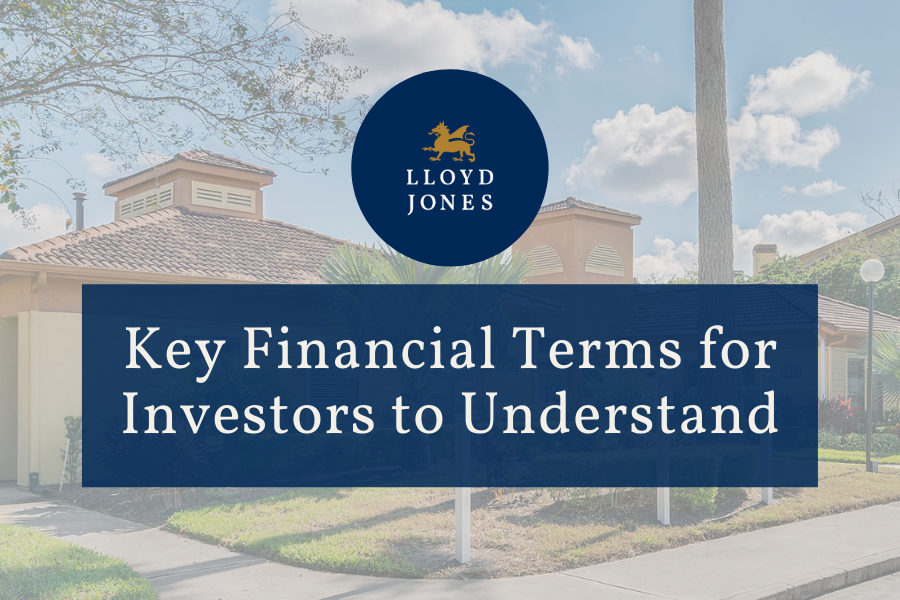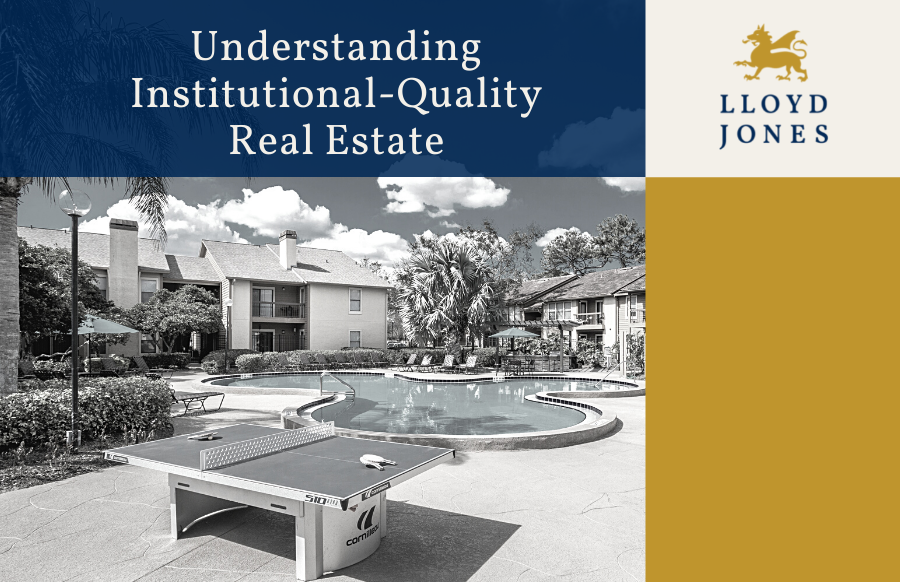Historically, commercial real estate has been considered an “alternative” asset class given its reputation as riskier than more traditional investments like stocks and bonds. In recent years, commercial real estate investing has become more mainstream. Investors find that one of the best ways to mitigate the risk associated with investing in real estate is by partnering with an experienced sponsor.
The due diligence process is lengthy and requires robust financial underwriting. A sponsor might look at dozens or even hundreds of deals before finding one that meets its underwriting criteria.
There are a few key metrics that most investors will want to consider as they evaluate deals. At Lloyd Jones, four of the metrics we carefully consider are cap rate, IRR, cash-on-cash return, and equity multiple. In this article, we explain each of these terms and how they influence the returns an investor might expect to earn.
Capitalization Rate (“Cap Rate”)

Investors will often use cap rate to quickly winnow their list of prospective opportunities. The cap rate is simply a formula used to estimate the potential return an investor will make on a property. Knowing the cap rate allows investors to easily compare properties.
The cap rate is expressed as a percentage that varies according to asset class, quality of the asset, geography and where we are in any market cycle. It tends to have an inverse relationship to property value—i.e., the higher the value, the lower the cap rate and vice versa.
The calculation used to derive the cap rate is as follows:
Net Operating Income / Purchase Price = Cap Rate
Net operating income, or NOI, refers to the total revenue a property generates over a one-year period after expenses. Debt is not factored into the cap rate calculation.
Cap rates are all relative. Whether a cap rate is “high” or “low” depends on the local market. While cap rates can be a useful tool for understanding the value of a property, most investors will want to understand what’s driving the cap rate. One way a sponsor may determine whether a cap rate is too low is by looking at the price per unit relative to the cap rate: is it an attractive basis, despite having a lower cap rate? If so, the property may be worth further consideration.
A “low” cap rate generally means either a) there is opportunity to increase revenue and extract further value, or b) the property is overpriced relative to its income-generating potential. Investors will want to know which is the case.
How To Influence Cap Rates
There are many ways a sponsor can improve the cap rate. The first category of improvements usually relates to physical improvements or service offerings that generate additional revenue, and therefore, increase NOI. For example, older vintage properties may be lacking the amenities of newer construction. Implementing a technology package (think: Nest thermostats, smart locks, and Wi-Fi-enabled outlets and lighting) can be a cost-effective way to increase rents since residents appreciate these technologies and see the value they bring. For example, at a property where residents are billed back for their actual utility consumption, the ability to control their thermostats from their mobile devices can result in significant cost savings.
Another amenity Lloyd Jones will often consider is adding valet trash. This is a service designed specifically for apartment buildings. On specified days, residents place their garbage outside of their doors in pre-provided containers that porters (either in-house maintenance people or third-party providers) then pick up and haul away to a larger dumpster on or off-site. This can generate another $20 to $25 in revenue per month, per unit.
While improvements can boost NOI, another way to improve the NOI is by lowering expenses. Sponsors will want to consider whether certain operational improvements can create cost savings.
During the due diligence process, a sponsor might, for example, look at whether payroll could be reduced. This is particularly true in situations where the sponsor owns other assets in that marketplace. Owning other assets locally provides a good baseline for what payroll costs should be, and often, there are ways to share resources across properties to lower the payroll costs per unit across the entire local portfolio.
Of course, after digging into the asset and its numbers, a sponsor may find there is no room to increase the NOI – through property improvements or operational efficiencies. In cases like these, if no further value can be extracted, the property may simply be overpriced on a cap rate basis alone.
Internal Rate of Return (IRR)
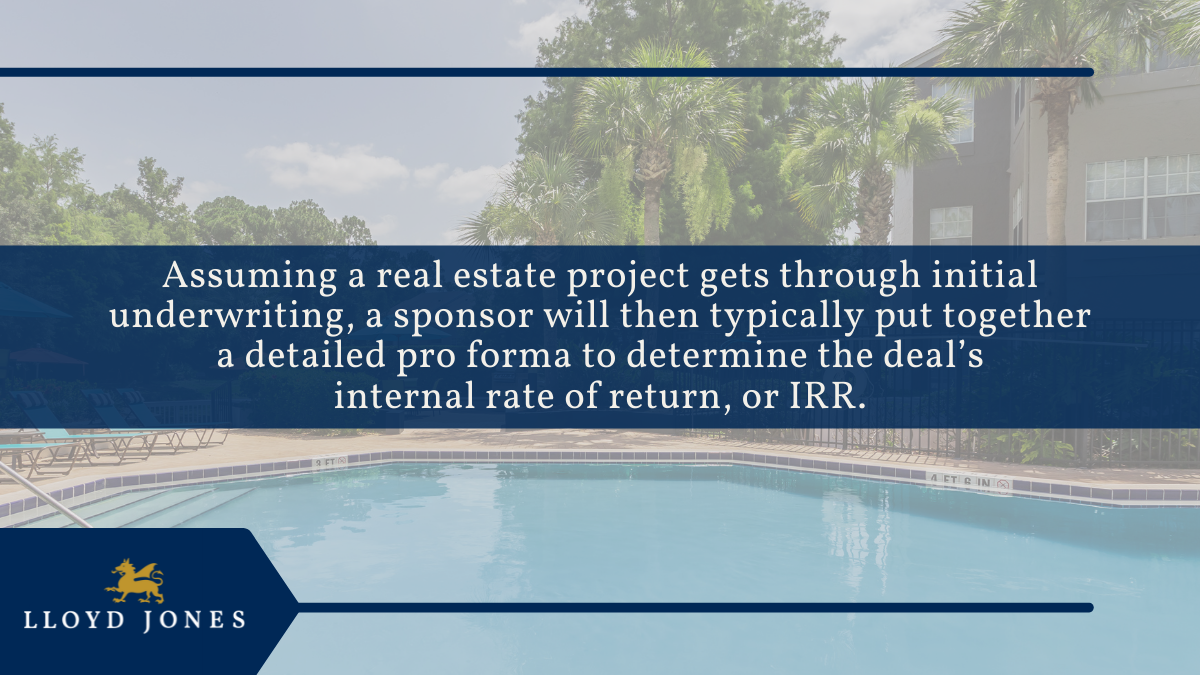
Assuming a deal gets through initial underwriting, a sponsor will then typically put together a detailed pro forma to determine the deal’s internal rate of return, or IRR.
The IRR is another way to value an investment property. The IRR attempts to express what someone will make on an investment over the course of the entire holding period, taking into consideration potential changes in income, property value, and debt service. The IRR expresses total returns on a project over the hold period, though actual returns may vary from year to year.
Calculating the IRR is complicated, partially because it relies on the abstract economic concept of “the time value of money.” In other words, we assume that a dollar received today is worth more than a dollar received in the future given inflation. The further in the future earnings are, the less valuable they become. To determine IRR, a sponsor must be able to project both annual cash flow from rent and profit earned upon disposition of the asset.
IRR is an important metric that can be used to supplement cap rates. Unlike cap rates, which provide a point-in-time perspective, the IRR calculation factors in NOI across multiple years and provides a more complete picture of potential returns.
Like cap rate, there is no “good” or “bad” IRR. An IRR is heavily influenced by asset class, the location, and the sponsor’s anticipated business plan (including its anticipated hold period). At Lloyd Jones, we have “target” IRRs depending on many factors. For example, on a newer asset, we may want to see an IRR of between 11 and 13 percent compared to a core-plus deal where the IRR may be somewhere between 13 and 16 percent. A value-add deal might warrant somewhere between 15 and 16 percent or more.
It is important to understand, though, that in today’s compressed market, IRR is a moving target. The IRR on day one of an investment will likely fluctuate during the hold period as market conditions evolve.
Cash-on-Cash Returns
In addition to cap rate and IRR, an asset’s projected cash-on-cash return is a metric that some investors use to evaluate investment opportunities.
Cash on cash return is a rate of return ratio that calculates the total cash earned on the total cash (equity) invested in a deal. Unlike other investment metrics, cash-on-cash return is a levered (i.e., after debt) metric. It is often referred to as the “cash yield” on an investment.
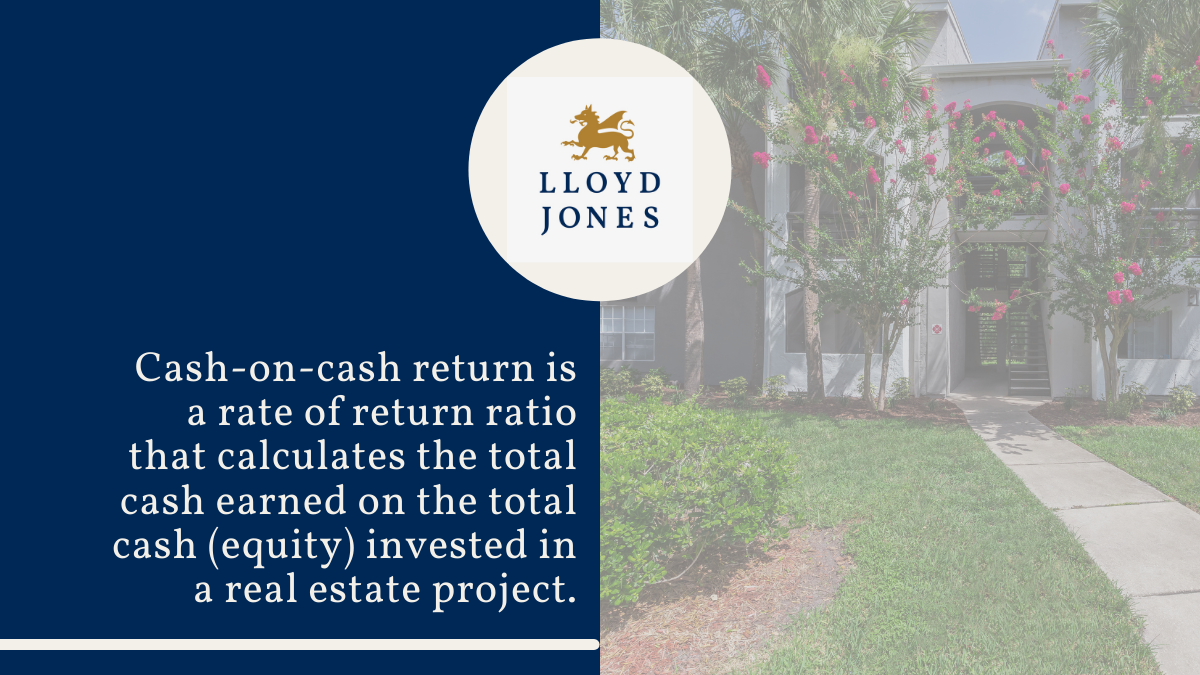
Cash on cash return is generally expressed as a percentage and is calculated as follows:
Annual Net Cash Flow / Invested Equity = Cash-on-Cash Return
The more equity invested in a deal, the lower the cash-on-cash return will be, assuming revenues and costs remain constant otherwise.
Knowing an asset’s projected cash-on-cash return allows investors to make a quick, side-by-side comparison of multiple deals based on rent roll, operating expenses, and other financials provided by the seller. A sponsor can then manipulate the numbers based on its projected financing terms, cost of anticipated improvements, and projected revenue growth to determine whether a specific asset has the ability to generate an acceptable cash-on-cash return for investors (knowing, of course, that what is “acceptable” will depend on the product type, location, and investors’ specific goals).
One downside to overly relying on cash-on-cash return projections is that this metric only considers annual net cash flow. It does not look at the total income earned over the duration of the hold period the way that IRR does, which means that the projected cash-on-cash returns could be especially skewed downward in the early years of ownership if a sponsor is executing a value-add strategy prior to full stabilization.
Equity Multiple
The equity multiple is a metric that can be used to supplement the others. It looks at the investment’s return as a multiple of the initial equity investment. The equity multiple formula is as follows:
Total Cash Distributions / Total Cash (Equity) Invested = Equity Multiple
For example, if someone invests $500,000 in equity into a deal and then earns $125,000 per year over a four-year hold period (in addition to the return of their initial $500,000 equity investment), the deal would be said to have a 2.0x equity multiple.
$125,000 x 4 years + $500,000 equity repaid = $1 million in total cash distributions
$1 million in cash distributions / $500,000 in original equity invested = 2.0x equity multiple
One drawback to using the equity multiple is that it does not consider how long it takes for an investor to earn that multiple return, the same way IRR would, for example. So, at first glance, one deal might have a higher equity multiple, but it could take twice as long for an investor to earn those returns. As always, a sponsor will want to pick apart the inputs to the equity multiple calculation to understand what’s driving that result.
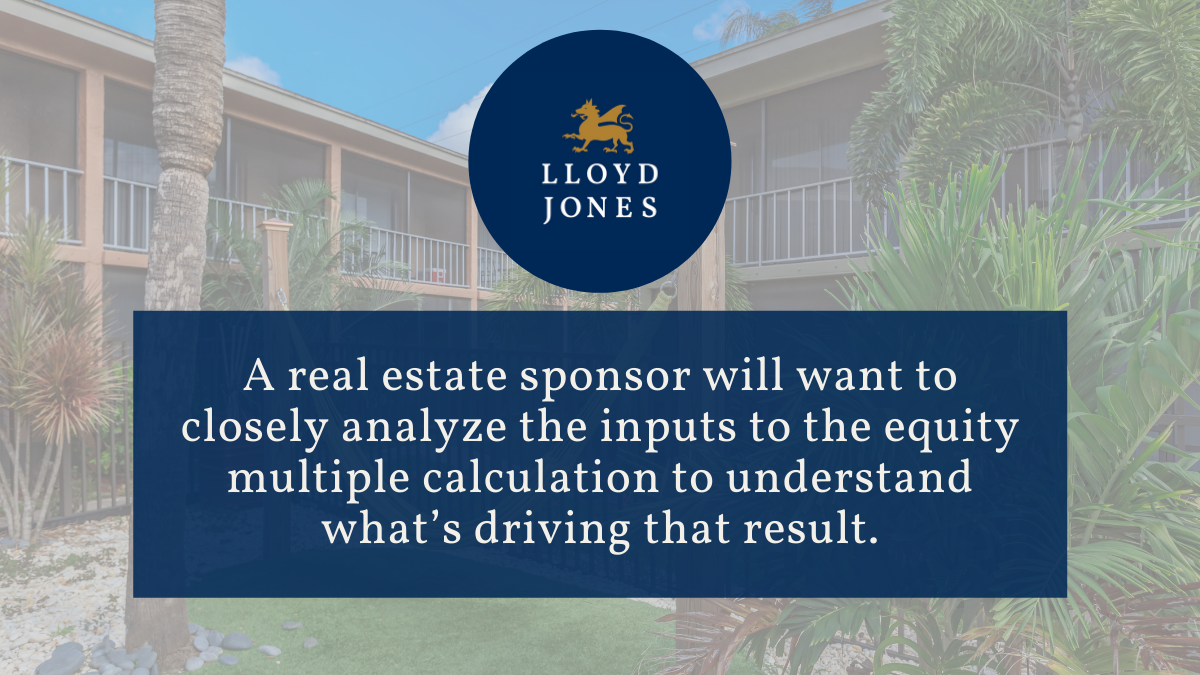
As we’ve shown here, each of these metrics can easily be manipulated based on different inputs and assumptions. For example, an asset with an unusually low cap rate should not necessarily be dismissed right out of the gate. Instead, our team will spend the time evaluating the inputs and searching for opportunity to extract further value. Only then, after careful analysis, will we determine whether something is a viable investment option or not.
Of course, these underwriting metrics should all be considered in the context of an individual’s investment objectives. Some investors, for example, are IRR driven while others are yield driven.
At Lloyd Jones, our team looks at a range of opportunistic deals, from value-add to new construction. We evaluate each of these deals based on whether they would be “attractive” to our investment partners, based on our partners’ predefined investment criteria. A deal that may not meet the investment threshold for one group of investors may be attractive to another group of investors because of total yield, hold period, risk level and more.
If you’re considering investing in commercial real estate, contact us today. Our team would be happy to discuss our investment platform with you in more detail.
